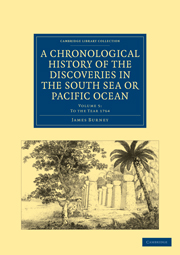Book contents
- Frontmatter
- Contents
- CHAPTER I The Carolinas, or New Philippine Islands
- CHAP. II Voyage of Lozier Bouvet, in 1738-9, to search for Lands in the Southern Atlantic Ocean
- CHAP. III Voyage round the World, by Commodore George Anson
- CHAP. IV Wreck of the British Frigate the Wager; and the subsequent Proceedings and Adventures of Captain David Cheap, and his Ship's company
- CHAP. V Missionary Voyage to Patagonia. Voyage of the French Ship Le Condé of St. Malo
- CHAP. VI Voyage of the Spanish Ship Leon, to Chili and Peru; and her Return to Europe
- CHAP. VII Monsieur de Bougainville to the Malouines, or Falkland Islands
- CHAP. VIII Of Islands marked in the Charts of the Pacific Ocean, and in the Tables of Situations, concerning which no other notices are found
- CHAP. IX CONCLUDING CHAPTER
- Index
- Plate section
CHAP. III - Voyage round the World, by Commodore George Anson
Published online by Cambridge University Press: 05 August 2011
- Frontmatter
- Contents
- CHAPTER I The Carolinas, or New Philippine Islands
- CHAP. II Voyage of Lozier Bouvet, in 1738-9, to search for Lands in the Southern Atlantic Ocean
- CHAP. III Voyage round the World, by Commodore George Anson
- CHAP. IV Wreck of the British Frigate the Wager; and the subsequent Proceedings and Adventures of Captain David Cheap, and his Ship's company
- CHAP. V Missionary Voyage to Patagonia. Voyage of the French Ship Le Condé of St. Malo
- CHAP. VI Voyage of the Spanish Ship Leon, to Chili and Peru; and her Return to Europe
- CHAP. VII Monsieur de Bougainville to the Malouines, or Falkland Islands
- CHAP. VIII Of Islands marked in the Charts of the Pacific Ocean, and in the Tables of Situations, concerning which no other notices are found
- CHAP. IX CONCLUDING CHAPTER
- Index
- Plate section
Summary
The unlicensed commerce which was carried on, mostly in British bottoms, between subjects of Great Britain and Spanish colonists in the West Indies, and the means resorted to by the Spanish Government for its prevention, had long furnished matter for complaint to both nations. The Spanish armed ships employed to watch the coasts, were authorised and directed to stop and search all British merchant vessels which should be found near any of their settlements; an extent which might be construed to comprehend every avenue to the Caribbean Sea. These orders gave opportunity to the guarda costas, when nothing contraband was found, to plague, detain, and in various ways to incommode, the ships that fell under their examination, and by that means to extort presents, as was practised by Shelvocke with the Portuguese ship on the coast of Brasil. Several English vessels were also wrongfully carried into Spanish ports and condemned. After much mutual remonstrance, the British Government peremptorily demanded that Spain should relinquish all claim to a right of visiting British ships except in her own ports. Spain, on the contrary, insisted on a general right to search suspected vessels, as the only way by which a contraband trade could be prevented. In 1739, these disputes ran so high, that letters of reprisal were issued by both parties, and declarations of war soon followed.
- Type
- Chapter
- Information
- Publisher: Cambridge University PressPrint publication year: 2011First published in: 1817



